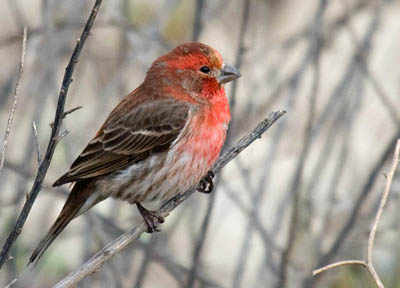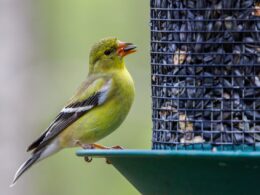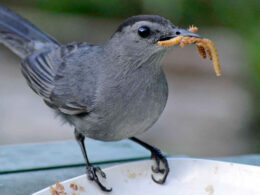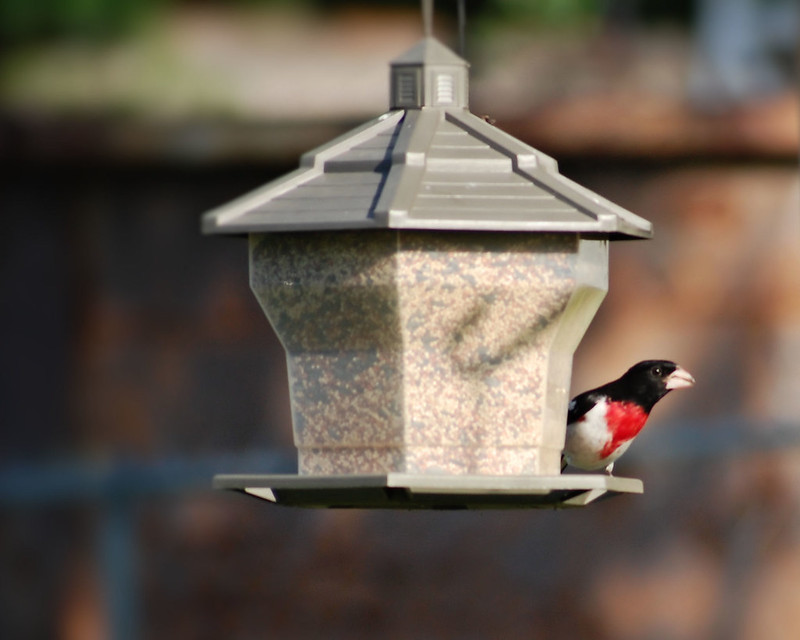Last Updated on January 24, 2024 by Greg Gillson
House Finches may be found at nearly every bird feeder in the United States!
They add a lively splash of color and activity to your feeders.
How do you attract House Finches to your bird feeder? Follow these suggestions to attract House Finches to your yard.
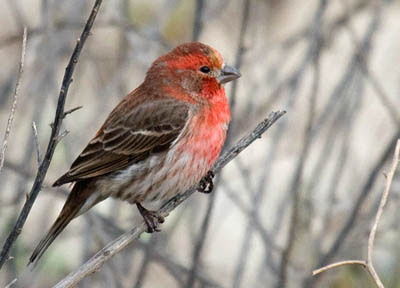 |
| Male House Finch. Greg Gillson |
Why attract House Finches to your bird feeder?
House Finches are very social. They hang out in small flocks throughout the year. Flock size is commonly 5 to 12 birds, sometimes up to 50.
Male House Finches sing throughout the year, though more so in spring and summer.
They are always lively and noisy–but in a happy, chirping way. Though they can get a bit feisty sometimes.
These birds are easy to attract to your bird feeder. They are often one of the first birds to visit after you first set up your feeder.
House Finches feed seeds to their nestlings, not insects as many similar seed-eating birds do. Thus, they will visit your bird feeder in summer, even as many other birds have abandoned the feeders during the nesting season.
Look for the young House Finches to visit your feeders with their parents in early summer. They will be begging for food from their parents even while sitting at the bird feeder! Look for fuzzy down feathers sticking out from their crown.
The red color on the forehead and breast of the males varies quite a bit in hue and intensity. This is influenced by diet. The red tends toward orange-red. Occasionally, House Finch males are yellow.
Females lack red color and are very streaky below. Thus, you can always tell the males and females apart when they visit your feeder.
All these attributes bring joy and excitement to your bird feeders.
 |
| Female House Finch. Greg Gillson |
What foods will attract House Finches to your feeder?
House Finches really love black oil sunflower seeds. They like the seeds in the shell better then sunflower kernels with shells already removed!
They crack the shell by chewing and then extract the meaty kernel with their tongue. Then they let the shell halves fall to the ground.
If you feed mixed seed, the House Finches will eat the sunflower seeds first. Then they’ll move on to the other seeds. But they may throw out the other seeds as they search for sunflower seeds.
The best mixed bird seed that I have found is Wagner’s Songbird Supreme. It is 50% sunflower seeds and doesn’t have any cheap filler seed that birds won’t eat. This seed attracts the largest variety of birds to your feeder.
House Finches will occasionally eat Niger seed from thistle or finch feeders.
House Finches will also eat berries, and fruit, including oranges and cherries.
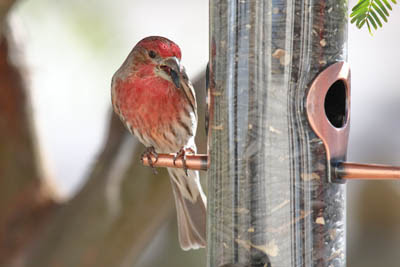 |
| House Finch eating black oil sunflower seed. Greg Gillson |
What kind of feeders do House Finches like?
House Finches love to eat from tube feeders. They are able to fend off House Sparrows better from tube feeders than from platform or hopper feeders.
Of course, they will also clean up spilled seeds from the ground.
I really love the way my iBorn tube feeder looks, with its copper top. A screwdriver takes off the lower perch and opens it up for cleaning. This feeder filled with black oil sunflower seeds attracts all types of finches, chickadees, and nuthatches. The smaller perches and lack of tray mean that you’ll have fewer House Sparrows, Starlings, Doves, and Jays at this feeder.
Where to place your bird feeder for House Finches
House Finches aren’t picky when it comes to bird feeder placement.
A tube feeder on a shepherds hook out in the lawn is fine. They don’t mind being in the open. When frightened they fly up into nearly trees or utility wires to watch for danger to pass.
They will eat from hopper feeders on your deck railing.
They will eat from small window-mounted feeders, too!
Just, in general, bird feeders should be placed above 4 feet in height to keep them safer from attacks from house cats.
They will also eat spilled seed on the ground.
 |
| House Finch. Greg Gillson |
How else can you attract House Finches to your yard?
House Finches seem to like to drink from the bird bath after eating.
They also bathe in bird baths. They like shallow water. And moving or dripping water really attracts them.
They eat buds and thistle seeds from weedy patches and fields. They will like foraging in an overgrown weedy garden in fall. But you might be able to attract them with a wildflower plot.
House Finches will not nest in a bird nest box. But they frequently build a nest in a wreath hanging on your door.
True to their name, they may also build a messy nest on a shelf or corner of a building, or on top of a porch light.
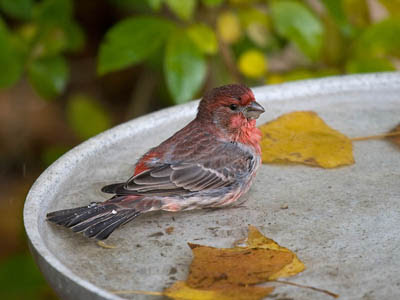 |
| House Finch. Greg Gillson |
Problems with House Finches: If you have attracted too many to your feeder
Because they are always in flocks, House Finches seem more susceptible than most to bird diseases spread at feeders. Avian conjunctivitis is a common House Finch disease, causing swollen eyelids, lethargy, and death.
If you see sick or lethargic birds at your feeder–or wildlife agencies announce it, stop feeding birds immediately. Empty bird baths. Take down bird feeders. Clean bath and feeder with bleach. Keep birds away for at least 2 weeks before setting them up again.
House Finches don’t eat suet very often. If they do, it is perhaps because of added fruit or nuts.
But for your other birds, you may consider feeding suet.
For my home feeders, I always purchase St Albans Bay Suet blocks. It comes in several flavors, including peanut and berry. They fit in required special suet cages, which are a type of bird feeder.
I bought a Nature’s Way Upside-down suet feeder a couple years ago and have been very happy with it. Chickadees, nuthatches, bushtits, and woodpeckers eat from it easily. But starlings, blackbirds, and jays can’t hang upside down to get at the suet.
Wrapping Up
Finches, belonging to the family Fringillidae, are a diverse group of small songbirds found all over the world except for Australia and Antarctica. Here are some of their key characteristics:
Physical:
- Size: Most finches are relatively small, typically ranging from 4 to 6 inches in length, excluding their tails.
- Shape: They have stout, conical beaks designed for cracking seeds and nuts. Finches also have round heads, slightly elongated bodies, and forked or notched tails. Their wings are pointed and powerful, allowing for agile flight.
- Plumage: Their plumage varies greatly depending on the species, ranging from brightly colored males with contrasting patterns to more subdued hues in females. Some common colors include brown, gray, black, white, yellow, red, and blue.
Behavior:
- Diet: Finches are primarily granivores, meaning their diet consists mainly of seeds. They also supplement their diet with insects, especially during breeding season when protein is needed for their young.
- Habitat: Finches occupy a wide range of habitats, including grasslands, forests, woodlands, shrublands, and even urban areas. They are adaptable birds and can thrive in diverse environments.
- Social behavior: Many finches are social birds and often live in flocks, foraging, flying, and roosting together. They also exhibit complex social interactions, including singing, courtship displays, and territorial defense.
- Breeding: Finches typically build cup-shaped nests in trees or shrubs. They lay clutches of 3-5 eggs and both parents care for the young.
- Song: Finches are well-known for their beautiful and varied songs. Males use their songs to attract mates and defend their territories.
Additional characteristics:
- Migration: Some finch species are migratory, traveling long distances between breeding and wintering grounds. Others are year-round residents in their chosen habitat.
- Intelligence: Finches are considered intelligent birds with good problem-solving skills. They can learn to use tools and even recognize individual humans.
- Cultural significance: Finches have been popular symbols in art, literature, and mythology for centuries. They are often associated with love, joy, and freedom.
These are just some of the general characteristics of finches. Remember that there are over 200 different species of finches, each with its own unique characteristics and adaptations.
Frequently Asked Questions
What is the difference between a House Finch and Purple Finch?
Telling a House Finch and a Purple Finch apart can be tricky, especially for males since both have red coloring. However, some key differences can help you identify them:
Coloration:
- Male House Finch: Reddish-orange or pinkish red concentrated on the head and breast, with brown streaking on the back and underparts.
- Male Purple Finch: Deep cranberry or raspberry red covering most of the body, with less brown streaking on the back and underparts. Some males may have faint streaking on the belly.
- Female House Finch: Plain brown overall with faint pale streaking, sometimes with a small, pale eyebrow stripe.
- Female Purple Finch: More crisply patterned with a bolder white eyebrow stripe and broader white markings on the underparts.
Other Features:
- Bill: House Finch has a thicker, stubbier bill, while the Purple Finch has a more pointed and slender bill.
- Tail: House Finch has a longer tail that extends beyond the wingtips when perched, while the Purple Finch’s tail is shorter, reaching roughly halfway down the wingtips.
- Overall shape: House Finch has a rounder head and a stockier body, while the Purple Finch has a sleeker profile and a more front-heavy appearance.
- Song: House Finch has a simple, high-pitched trill, while the Purple Finch has a more complex, warbling song.
Are House Finches good to have around?
Whether House Finches are “good” to have around depends on your perspective and priorities. Here’s a breakdown of their pros and cons:
Pros:
- Beautiful and cheerful: Their vibrant red plumage (males) and lively songs add a touch of color and music to gardens and backyards.
- Insect control: They primarily eat seeds, but also consume insects, especially during breeding season, helping to control pest populations.
- Pollination: By visiting flowers for nectar, they contribute to plant pollination, aiding in the growth of fruits and vegetables.
- Easy to attract: They readily visit bird feeders, offering opportunities for close observation and enjoyment.
- Adaptable and resilient: They thrive in diverse environments, including urban and suburban areas, making them common backyard visitors.
Cons:
- Seed feeders: They can be aggressive at feeders, dominating other birds and consuming large amounts of seeds. This can be frustrating for those who want to attract a wider variety of birds.
- Disease vectors: They can carry and transmit diseases like salmonella and conjunctivitis, especially around feeders where hygiene might be lacking. Proper feeder cleaning and hygiene are crucial.
- Nest parasites: In rare cases, their nests can be parasitized by Brown-headed Cowbirds, which lay their eggs in finch nests, leaving the finches to raise the cowbird chicks at the expense of their own young.
- Damage to fruit trees and gardens: Occasionally, they may peck at ripening fruit or buds on trees and shrubs, causing minor damage.
Will a finch nest in a birdhouse?
Finches will occasionally nest in birdhouses, but they are not their preferred nesting location. Here’s a breakdown of their nesting habits and suitability for birdhouses:
Finch Nesting Preferences:
- Natural sites: Finches generally prefer to build their own nests in trees, shrubs, vines, or even human-made structures like hanging baskets or wreaths. They construct cup-shaped nests using twigs, grass, leaves, and other materials.
- Adaptability: While not their first choice, some finch species, especially House Finches, can readily adapt to and utilize birdhouses if suitable natural sites are unavailable.
Birdhouse Suitability:
- Size and type: Finches prefer smaller birdhouses with entrance holes around 1 to 1.5 inches in diameter. Open-fronted nest boxes might also be used by some species like House Finches. Larger birdhouses are less likely to attract them as nesting sites.
- Location: Place the birdhouse in a sheltered location with some protection from rain and sun. Choose a spot near trees or shrubs for easier access to nesting materials and cover.
- Competition: Avoid placing the birdhouse near competing nest sites used by other birds, as finches might be reluctant to compete.
Related Articles:
Why aren’t birds coming to your feeder?
First in series: Irresistible! Attract Mourning Doves to your feeder






